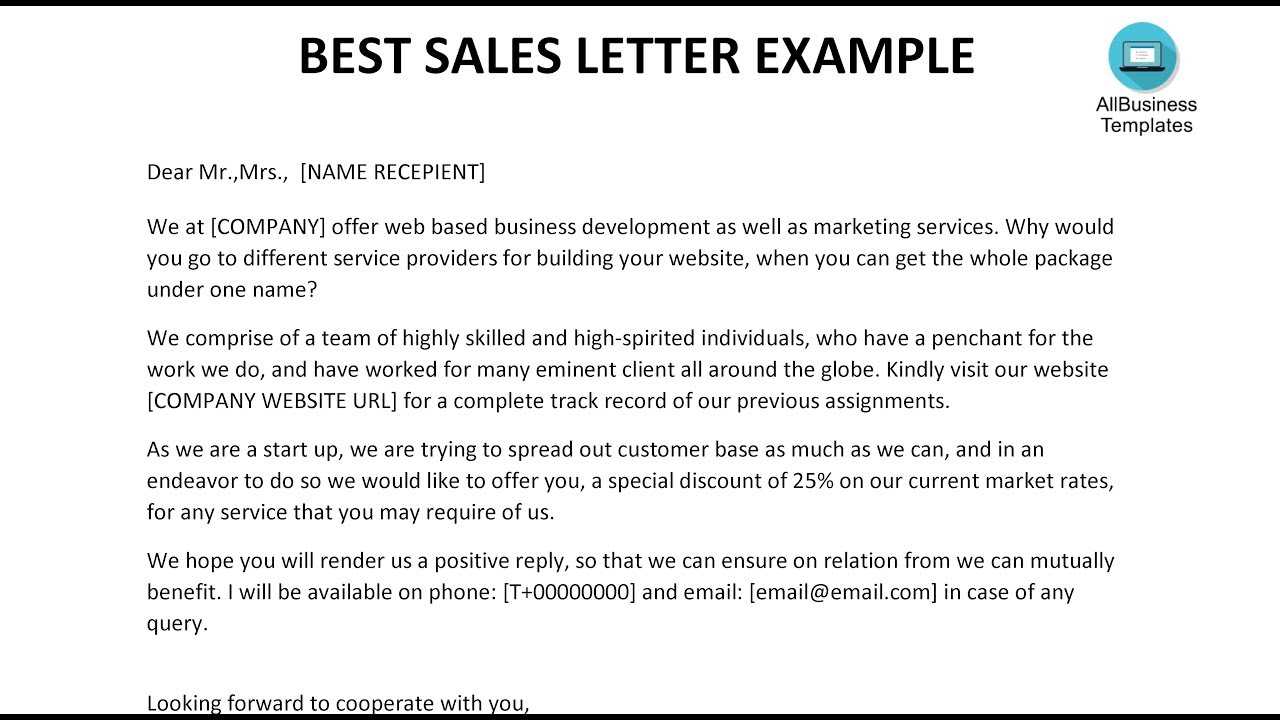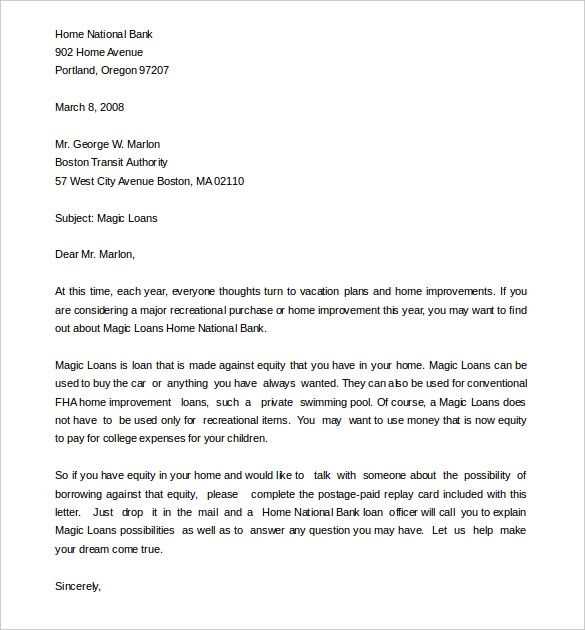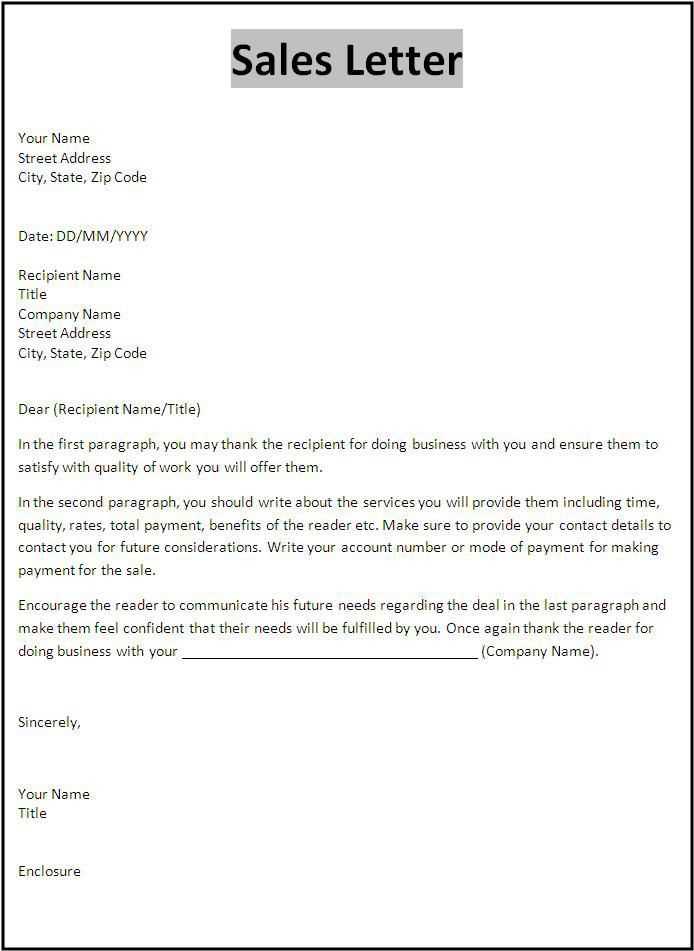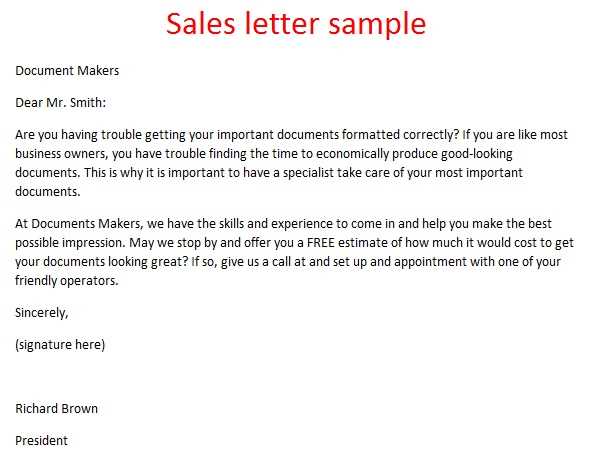Sales Prospecting Letter Template for Successful Outreach

Reaching out to potential clients is a crucial step in building long-lasting business relationships. The key to a successful connection lies in the structure and tone of your communication. Whether you’re introducing your product or seeking to establish a partnership, a well-written approach can make a significant impact on your results.
When designing a message to capture the interest of your prospects, it’s important to consider both the content and the presentation. A concise and tailored note can speak volumes, and understanding the nuances of how to frame your offer is essential. Customizing each message based on the recipient’s needs increases the chances of starting a meaningful conversation.
In this section, we’ll explore effective strategies for crafting your outreach messages, focusing on structure, tone, and the most common techniques to engage potential clients. With the right approach, you can increase your chances of standing out and receiving positive responses.
Understanding the Outreach Process

The process of reaching out to potential clients is a vital component of business development. It involves identifying the right individuals or companies to target and crafting messages that resonate with their specific needs. Successful communication can lead to valuable connections, while a poorly structured approach can result in missed opportunities.
Effective outreach begins with understanding your audience. It’s essential to know what drives your prospects, their pain points, and how your offer can provide a solution. The goal is to spark interest and initiate a dialogue that opens the door to further discussions.
The steps in this process can be broken down into several key stages:
- Researching Potential Clients: Identify businesses or individuals who would benefit from your product or service. Thorough research ensures you are targeting the right people.
- Crafting a Message: Tailor your communication to highlight how your offering addresses the recipient’s specific needs or challenges.
- Reaching Out: Send your initial message through the appropriate channel, whether it’s email, phone, or social media, and ensure the timing is right.
- Engaging in Conversation: Follow up on responses, address any questions, and keep the conversation going by offering more insights or solutions.
- Building a Relationship: Establish trust over time by remaining consistent and helpful in your communications.
By following a structured approach, businesses can build a pipeline of interested prospects who are more likely to convert into loyal customers. Each stage plays a crucial role in developing a relationship that can lead to long-term success.
Key Elements of an Effective Outreach Message
An effective communication designed to engage potential clients must be clear, concise, and relevant. A well-crafted message grabs attention, builds rapport, and encourages further interaction. The elements within the message are critical to its success and should be thoughtfully structured to resonate with the recipient.
The following key components are essential to creating an outreach message that stands out:
Personalization and Relevance
- Tailor the content: A generic approach often feels impersonal. Customize your message to reflect the prospect’s business needs and demonstrate how your offer aligns with their goals.
- Include specific details: Reference relevant data or experiences that show you’ve done your research and understand their challenges.
Clear and Concise Value Proposition

- State the benefits: Focus on the outcomes your prospect will achieve by engaging with you. Highlight the most relevant advantages that resonate with their situation.
- Be specific: Avoid vague statements. Clearly articulate what sets you apart from others and why your solution is the best fit.
In addition to these, the tone should remain professional yet approachable, aiming to spark curiosity and initiate a conversation. Keeping the message focused, without unnecessary details, is crucial for maintaining interest and encouraging action.
How to Personalize Your Outreach Message
Personalization is a key element in any communication aimed at engaging potential clients. By making the message feel unique and tailored to the individual, you increase the likelihood of capturing their attention and starting a meaningful conversation. Customizing your approach shows that you understand the recipient’s specific needs and have put thought into how your offer can provide value to them.
Research and Understanding Your Recipient
Before reaching out, take the time to learn about the person or business you are contacting. This knowledge allows you to craft a message that speaks directly to their current challenges, industry trends, or specific goals. A few ways to personalize include:
- Identify their pain points: Demonstrate an understanding of the challenges they may be facing and how your offering can resolve these issues.
- Reference recent actions: Mention any recent activities or changes they’ve made, such as new product launches, recent expansions, or achievements.
- Use their name: Incorporating the recipient’s name in the message adds a personal touch that makes the communication feel more direct and engaging.
Customizing the Value Proposition
Once you’ve gathered relevant information, it’s important to adapt your value proposition to align with the recipient’s unique circumstances. Instead of offering a generic pitch, focus on how your solution directly meets their needs. You can achieve this by:
- Focusing on outcomes: Highlight the specific results the prospect will achieve by engaging with you, tailored to their industry or business model.
- Making it relevant: Show how your offering fits into their current workflow or improves their existing operations, rather than providing a broad solution that may not apply to their situation.
Personalization makes your message stand out in a crowded inbox. By demonstrating that you’ve taken the time to understand your recipient and tailor your communication to their specific needs, you increase your chances of fostering a productive relationship.
Common Mistakes in Outreach Communications
When reaching out to potential clients, it’s easy to make mistakes that can hinder the effectiveness of your message. These errors can lead to a lack of engagement or even damage your reputation. Avoiding common pitfalls will increase the likelihood of your message resonating with the recipient and opening the door for further conversations.
Overly Generic Messages
One of the most frequent mistakes is sending a message that feels impersonal or too generic. Prospects can quickly tell when they are receiving a mass communication that lacks relevance to their specific needs. This can result in your message being ignored or dismissed. To avoid this:
- Customize your content: Ensure that the message speaks directly to the prospect’s industry, challenges, or goals.
- Use their name: Addressing the recipient by name makes the message feel more personal and thoughtful.
Failing to Communicate Clear Benefits
Another common issue is not clearly articulating the value your offering provides. Without focusing on the specific benefits, the recipient may not understand why your product or service is relevant to them. To improve this:
- Be specific: Focus on the outcomes that matter to the prospect. Clearly outline how your solution will solve their problems or improve their business.
- Avoid jargon: Keep the message simple and direct, ensuring that the recipient can quickly grasp the value proposition.
Avoiding these mistakes will improve your chances of capturing the attention of potential clients and starting meaningful conversations. By being personal, clear, and focused, your outreach will stand out in a positive way.
Improving Response Rates with Your Outreach Message
Increasing the likelihood of a positive reply starts with crafting a message that resonates with the recipient. By refining your approach and focusing on what matters most to the potential client, you can enhance engagement and encourage responses. Several key factors can significantly improve the effectiveness of your outreach and drive better results.
Clarity and Conciseness

One of the primary factors in boosting response rates is making your message clear and to the point. Busy professionals often skim through messages, so it’s crucial to convey your value proposition quickly and effectively. Avoid unnecessary jargon and get straight to the benefits.
Timing and Follow-Up
Another important aspect is the timing of your communication and following up strategically. A well-timed message can be more impactful, and following up shows persistence without being overbearing. Ensure you are patient but consistent in reaching out to prospects.
| Action | Best Practice | Outcome |
|---|---|---|
| Personalization | Tailor the message to the recipient’s specific needs and business challenges. | Higher engagement and a stronger connection with the prospect. |
| Clear Value Proposition | Clearly state the benefit and solution provided. | Increased interest and better understanding of your offering. |
| Follow-up | Send a polite follow-up message if no response is received. | Improved chances of a reply and continued communication. |
By focusing on these areas, your outreach messages are more likely to stand out, grab the attention of potential clients, and encourage them to engage with your proposal.
Best Practices for Following Up After Sending

Following up after sending an initial message is essential for maintaining engagement and ensuring that your outreach does not go unnoticed. It’s important to approach follow-ups in a way that is both strategic and respectful of the recipient’s time. By adhering to best practices, you can increase the chances of receiving a positive response and continue building a meaningful connection.
Timing Your Follow-Up
Timing is crucial when following up. Too soon, and you may come across as impatient; too late, and the prospect may have lost interest. A general rule of thumb is to wait around 3-5 business days before sending a reminder message. This gives the recipient enough time to consider your initial communication without feeling rushed.
Crafting a Thoughtful Follow-Up Message
Your follow-up should never feel like a mere reminder; it should offer value and encourage further dialogue. Reference the initial communication, but highlight how your offering can help the prospect. Personalizing the message further can help rekindle interest and show genuine care in providing a solution.
- Be polite: A respectful tone is key to maintaining a positive rapport.
- Reiterate the value: Mention the main benefit again, but don’t overwhelm the reader.
- Offer additional information: Provide useful insights or offer to answer any questions the recipient might have.
By following these guidelines, your follow-up messages will be more effective, demonstrating professionalism and a keen interest in engaging with the recipient. Patience and consistency are the keys to achieving a successful connection.